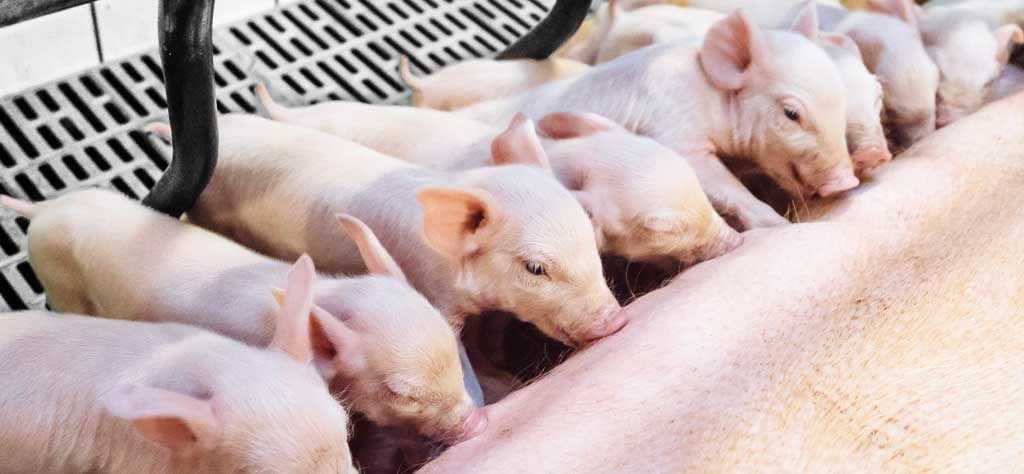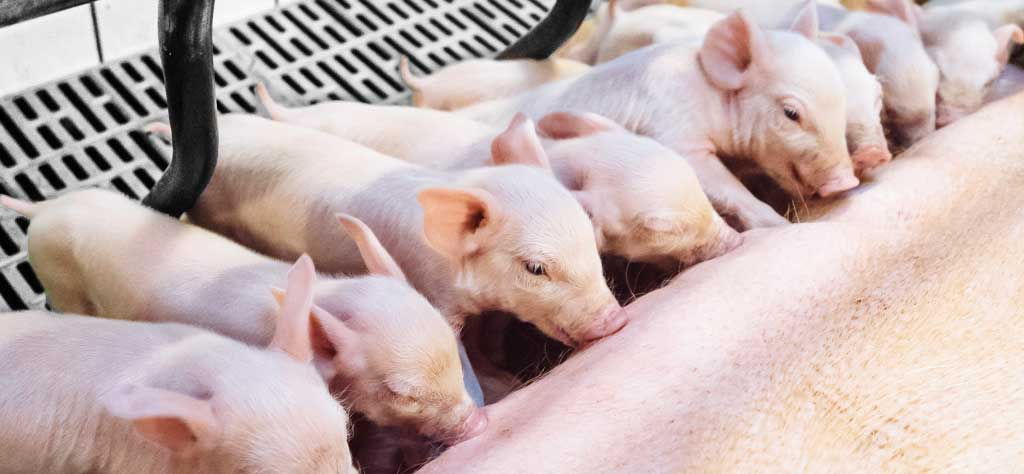Building and boosting the immunity shield of pigs

Conference report
A well-functioning immune system is vital for the survival and performance of animals. It helps piglets cope with challenging periods, such as their first days of life or weaning. Measures can be taken around farrowing to support the piglets during their first days by enhancing the quality and quantity of colostrum and helping them develop their own immune system as fast as possible.
Adequate feeding of the sow before and around farrowing
Feeding of both the sow and the piglet has an important influence on farrowing, the health of the sow, colostrum and milk production, piglets’ development of immunity, and their later performance. A well-functioning immune system is crucial for the piglets to withstand upcoming challenges such as weaning.
Colostrum quality can be influenced by feeding
Newborn piglets have no functioning immunity system. They rely entirely on immunoglobulin G (IgG) absorption from colostrum within the first few hours after birth to establish their immunity shield. Dr. Megan Edwards, Animal Nutrition Consultant from Integral Nutrition (S) Pte Ltd, highlighted the payback of adequate colostrum quality and intake: Adequate colostrum intake can positively affect whole-of-life immunity and, ultimately, growth performance. The contained IgG is essential for providing passive immunity to piglets, protecting them from infections during their early days of life when their immune systems are still developing. There is a positive correlation between the amount of IgG they absorb from colostrum and their performance. This benefit of colostrum intake is independent of birth weight.
We have a 3-week window to influence colostrogenesis. However, the fat content of colostrum is determined in the last 48 hours before farrowing. According to Dr. Edwards, influencing colostrum quality is generally easier than affecting quantity. She identified several compounds that can serve as immunomodulators, such as MCFAs, yeast extracts, and butyrate. However, by moving IgG to colostrum and milk in late gestation and lactation, the sow compromises her immunity status by depleting her own reserves for about two weeks.
Feeding at farrowing
Sow body condition has been shown to have more impact on colostrum yield than feeding level. The highest colostrum yield was achieved when sows entered the farrowing unit with a moderate body condition (3-3.25 – the ribs, spine, and hip bones can only be felt with firm pressure but are not visibly prominent). Overfeeding should be avoided to prevent sows from becoming excessively fat pre-farrowing.
Sows experience increased energy demands during farrowing due to the physical demands of parturition and the physiological changes occurring in their bodies. Dr. Edwards does not encourage withholding feed on the day of farrowing and suggests offering up to 3kg if the sow has the appetite. Feeding just below the energy requirement helps the sow to mobilize her own body fat.
Many producers mistakenly withhold feed on the day of the farrow to reduce the incidence of constipation. Feeding, however, stimulates gut motility. Withholding feed can slow down gut transit time and actually increase the likelihood of constipation.
Piglet feeding for developing intestinal tract and immune system
In piglet feeding, two strategies are decisive: the early intake of immunoglobulins via colostrum to protect the piglets against pathogens during their first days of life and the offering of creep feed to stimulate their intestinal development.
High-quality colostrum as much and as soon as possible
When the piglets are born, it is of the highest importance that they ingest colostrum as much and as soon as possible. The piglet can only absorb intact large IgG molecules, the primary source of passive immunity, before gut closure, which begins about 6–12 hours after birth and progresses rapidly to completion in about 24 hours. In any case, the sow will start producing milk by this time and no more colostrum. The concentration of colostrum IgG decreases by 50% within 6 hours after the birth of the first piglet. The target is for piglets to consume 250 g of colostrum within the first 24 hours, ideally within the first 6 hours. However, about 30% of sows produce insufficient colostrum.

(Hasan et al. 2019; the numbers of piglets are shown in parenthesis)
Split suckling jump-starts weak piglets
Split suckling is an effective management strategy to improve piglets’ access to colostrum and milk, particularly in increasingly common situations where sows give birth to large litters. This involves temporarily separating the more vigorous piglets from the sow to allow smaller or weaker piglets better access to the teats. This method helps ensure that all piglets receive adequate nutrition during the critical early hours after birth.
Large litters provoke energy deficiency in piglets
Piglets are born with limited energy reserves (glycogen and brown fat tissue). Ingestion of colostrum is associated with a considerable increase in the metabolic rate, contributing to maintaining body temperature. About 70% of the piglets’ energy requirement in the first 72 hours is provided by colostrum. “Most piglets that die within this period do so primarily due to energy deficiencies rather than immune-related issues. The trend towards larger litter sizes has exacerbated the issue of energy deficiency,” stated Dr. Edwards.
Creep feeding
The primary role of creep feed is to accelerate the development of the piglets, their digestive and immune systems, and their gut microbiome, not for weight gain. Creep feeding helps evolve digestive enzymes and acid secretion necessary for breaking down complex carbohydrates and proteins. This early feeding supports piglets in adapting to solid diets, mitigating stress during weaning.
Creep feeding also helps piglets develop an oral tolerance to avoid transient hypersensitivity due to various dietary ingredients. This process is essential for preventing allergic reactions and hypersensitivity, which can occur when the immune system mistakenly identifies harmless substances as threats. It takes about two weeks for the piglet to recognize an ingredient as a nutrient, not a pathogen. To facilitate this process, she recommends that creep diets contain a broad range of ingredients at low doses. This approach gradually exposes piglets to various nutrients, allowing their immune systems to adapt without overwhelming them with high concentrations of any single ingredient.
Mycotoxins must be managed – even in piglets
The significance of mycotoxins in piglets is often underestimated due to their relatively small feed intake. However, there is substantial evidence that mycotoxins can be transferred from sows to piglets through colostrum and milk, which can have profound health implications.
Dr. Edwards is convinced that managing mycotoxins is managing immunity. Mycotoxins are transferrable via the placenta, colostrum, and milk. There is a positive correlation between the mycotoxin levels in feed and colostrum. For example, adverse effects seen in piglets consuming colostrum with low doses of deoxynivalenol (DON) include:
• Decreased villus height
• Reduced mucosal integrity
• Increased inflammation
• Alternated immune response
The bottom line is that mycotoxins are a real and everyday risk to the immune quality of your piglets.
Nutrition influences piglets’ immune development
Dr. Edwards summarized that adequate nutrition is fundamental for developing a strong immune system in pigs, which is the basis for high performance. By focusing on the appropriate nutrition of the sow, ensuring an adequate intake of high-quality colostrum intake in piglets, and implementing creep feeding strategies, producers can significantly enhance the lifetime health and productivity of their piglets from an early age.
EW Nutrition’s Swine Academy took place in Ho Chi Minh City and Bangkok in October 2024. Dr. Megan Edwards, an Australian animal nutrition consultant with global research and praxis experience and a keen interest in immuno-nutrition and functional nutrients, was an esteemed guest speaker at this event.



